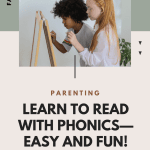So your kiddo is ready to learn to read, and you want to make sure it goes smoothly. You also want to make sure they actually do learn to read, rather than struggling with reading concepts. Perhaps you’ve been researching different methods for teaching your child to read, and a phonics-based approach seems to be the best way to go.
Why is it important for children to learn to read with phonics? So what is phonics, anyway? And why is it so important?
Phonics is a method of helping children learn to read by teaching them the relationship between sounds and letters. It’s based on the principle that letters and letter patterns represent sounds, and by learning these letter-sound associations, children can decode words and learn how to read. Phonics-based instruction focuses on teaching children the individual sounds of letters and letter combinations and how they blend together to form words.
Phonics instruction has numerous benefits for early reading development. For starters, it helps children develop strong decoding skills, enabling them to sound out unfamiliar words independently. This helps them become confident readers who can tackle any text with ease. Secondly, phonics enhances spelling skills as children learn the rules governing letter-sound relationships. And finally, phonics instruction improves overall reading comprehension as children gain a deeper understanding of how words are constructed.
How phonics enhances comprehension to develop reading skills
Phonics plays a crucial role in enhancing comprehension and overall reading skills. By teaching children the sounds associated with each letter or group of letters, they can break down unfamiliar words into manageable parts. This allows them to learn to read unfamiliar words and understand their meaning within the context of a sentence or passage. Phonics also helps children recognize patterns in language, such as a word’s root, similar words, and common prefixes or suffixes, which further aids in comprehension.
Numerous studies have shown the effectiveness of systematic phonics instruction in improving children’s reading abilities. Research consistently demonstrates that explicit teaching of letter-sound correspondences leads to improved word recognition skills, spelling abilities, and overall reading comprehension.
READ MORE: 5 Practical Tips For Developing Kindergarten Readiness at Home

What are the proven strategies to teach phonics to children?
There are several proven strategies that can effectively teach phonics:
1. Start with phonemic awareness
Before introducing letter-sound correspondences, it is essential for children to develop an understanding of individual sounds in spoken language (phonemic awareness). Engage in activities such as rhyming games, identifying initial sounds in words, and blending sounds together.
2. Use multi-sensory approaches
Incorporate different senses, such as sight, sound, and touch, to reinforce letter-sound connections. For example, have children trace letters while saying the corresponding sound aloud.
3. Provide ample practice opportunities
Offer a variety of engaging activities that allow children to practice their phonics skills. This can include word-building games, reading books with phonetic patterns, and playing interactive online phonics games.
Phonemic and phonological awareness: The first step to reading
Before embarking on formal phonics instruction, children must develop phonemic and phonological awareness. Phonemic awareness refers to the ability to identify individual sounds (phonemes) in spoken words. This includes recognizing rhyming words, blending sounds together to form words, segmenting words into individual sounds, and manipulating sounds within words (e.g., changing the beginning sound of “cat” to “bat”). Phonological awareness goes beyond individual sounds and encompasses broader aspects of language such as syllables, onset-rime awareness (recognizing the initial consonant sound followed by the remaining part of a word), and understanding rhyming patterns in language. Phonemic awareness is the best way to prepare your child to learn to read.
Tips for making learning letters and sounds fun and engaging
Learning letters and their corresponding sounds can be made fun and engaging for young children through various activities:
1. Alphabet scavenger hunt: Hide letter cards around the house or classroom for your child to find. As they discover each letter, encourage them to say the sound aloud.
2. Sensory letter tracing: Fill a tray with sand or salt and have your child use their fingers or a paintbrush to trace letters while saying the corresponding sounds.
3. Letter sound matching: Create a matching game and let your child match picture cards to the corresponding letter or sound.
4. Alphabet songs and rhymes: Create songs and rhymes to help your child remember letter sounds.
Decoding words and sounding out words: The stepping stone to literacy
Decoding words is a fundamental skill that children acquire through phonics instruction. It involves breaking down words into individual sounds and blending them together to form recognizable words. By teaching children the rules of phonics, they can confidently decode unfamiliar words and build their reading skills.
Reading aloud to help children recognize new words
Reading aloud also helps children learn to read beginning words, recognize new words, and expand their vocabulary. When parents or teachers read to children, they expose them to a wide range of vocabulary, sentence structures, and storytelling techniques. This exposure helps children develop word recognition skills as they encounter new words in context. Reading aloud also fosters a love for reading and creates positive associations with books.
How to use books and reading programs to help children develop reading skills and reinforce phonics learning
Books and reading programs are valuable tools for reinforcing phonics learning. Here are some ways to incorporate them into your child’s reading journey:
1. Choose phonics-based books: Look for books that emphasize phonetic patterns and include words that align with the letter-sound correspondences your child is learning. This allows them to practice their decoding skills in a meaningful context.
2. Use leveled readers: Leveled readers provide a structured progression of texts that gradually increase in difficulty. Start with simple texts that focus on basic letter-sound correspondences and gradually move towards more complex texts as your child’s skills develop.
3. Hunt for online resources: There are numerous online reading programs and apps available that provide interactive activities, games, and ebooks designed to reinforce phonics skills.
How to select a book that aligns with your child’s phonics instruction?
When selecting a book that aligns with your child’s phonics instruction, consider the following factors:
1. Letter-sound correspondences: Choose books that contain words and sentences that align with the letter-sound correspondences your child is currently learning.
2. Gradual progression: Look for books that gradually increase in difficulty, allowing your child to practice and reinforce their phonics skills at an appropriate level.
3. Sight words: Ensure the book incorporates sight words (high-frequency words) that your child has already learned to provide opportunities for reading fluency.
4. Engaging content: Select books with engaging stories, colorful illustrations, and relatable characters to captivate your child’s interest and make reading enjoyable.
How do books help kids sound out new words and improve comprehension?
Books play a crucial role in helping children become better readers. As children encounter unfamiliar words in context, they can apply their phonics knowledge to decode these words by breaking them down into individual sounds. This decoding process enables them to learn to read by pronouncing the word correctly and understanding its meaning within the sentence or story.
Following the grade and reading instruction to pick the right book
To pick the right book for your child, consider their grade level and current reading abilities. Consult their teacher or refer to grade-level reading lists provided by educational institutions or organizations. These resources can guide you in selecting books that are appropriate for your child’s developmental stage and reading proficiency.
READ MORE: Getting Kids to Read More for Fun—7 Tempting Ideas!

When and how to start phonics instruction for preschool and kindergarten-age kids?
Phonics instruction can begin as early as preschool when children are developing foundational language skills. While some preschoolers may not be ready for formal phonics lessons, there are activities you can incorporate into their daily routine to lay the groundwork for future reading success:
- Learning the alphabet: Systematically teach children the sound of each letter by working your way through the alphabet.
- Letter-sound association: Teach children the sound associated with each letter through songs, rhymes, and interactive games.
- Phonemic awareness activities: Engage children in activities that develop phonemic awareness, such as identifying initial sounds in words or clapping out syllables.
Benefits of early phonics instruction in preschool and kindergarten
Early phonics instruction for preschoolers can be of tremendous value to your child:
- A Strong foundation: Introducing phonics early helps children develop a strong foundation in letter-sound correspondences and prepares them for future reading instruction.
- Language development: Phonics instruction enhances overall language development by promoting vocabulary growth, listening skills, and understanding of how words are constructed.
- Confidence building: Learning to read at an early age builds confidence and enthusiasm for reading, setting the stage for a lifelong love of books.
Tips to make early reading easy and fun for preschoolers and kindergartners
To make early reading easy and fun for preschoolers and kindergartners, consider the following:
- Create a print-rich environment: Surround your child with labels, signs, and printed materials at home or in the classroom to expose them to written language from an early age.
- Read aloud regularly: Set aside dedicated time each day to read aloud to your child. Choose engaging books with colorful illustrations and interactive elements that capture their attention.
- Incorporate play-based activities: Use games, puzzles, and hands-on activities that reinforce letter recognition, letter-sound correspondences, and early reading skills.
- Make it interactive: Encourage your child to actively participate in reading activities by pointing out letters or words, sounding out simple words together, or retelling stories in their own words.
Common mistakes to avoid when teaching preschooler kids and kindergartners to read with phonics
If you’re teaching a preschooler to read with phonics, it’s important to avoid the following common mistakes when your child isn’t reading as well as you think they should:
- Pushing too hard: Each child develops at their own pace, don’t push them beyond their readiness level. Allow them to progress naturally, providing support and encouragement along the way.
- Focusing solely on phonics: While phonics is an essential component of reading instruction, it should be complemented with other literacy activities such as storytelling, vocabulary development, and exposure to a variety of texts.
- Neglecting oral language development: Phonics instruction should be accompanied by activities that promote oral language development, such as conversations, discussions about books, and storytelling.
How to monitor your preschool child’s reading development
Monitoring your preschooler’s reading development is essential for identifying areas of strength and areas that may require additional support. Here are some ways you can monitor your child’s progress:
- Observe their interest in books: Notice if your child shows enthusiasm for books and reading-related activities.
- Assess letter recognition: Regularly assess your child’s ability to recognize letters of the alphabet both in isolation and within words.
- Track sight word knowledge: Keep track of the sight words your child has learned and monitor their ability to recognize these words accurately.
- Observe decoding skills: Pay attention to how well your child can sound out simple words using their knowledge of letter-sound correspondences.
At this stage of the game, don’t worry about whether or not your child is adept at writing letters. Many small children have not yet developed the motor skills to focus on handwriting. Your child is a beginner! Please don’t expect too much at this early age.
Addressing common reading problems kids face when learning to read with phonics
Both at home and at school, students learn to read at their own speed, and learning to read with phonics can pose certain challenges for some children. Here are some common challenges these kids may face and strategies to address them:
- Blending sounds: Some children may struggle with blending individual sounds together to form words. Provide additional practice opportunities and use multisensory techniques such as tapping out sounds or using manipulatives. And try singing! Singing words helps to lesson the staccato beat kids use when sounding out words.
- Remembering letter-sound correspondences: Help children reinforce letter-sound correspondences through repetition, visual cues, and interactive activities.
- Recognizing irregular words: English has many irregularly spelled words that do not follow typical phonetic patterns. Encourage children to memorize these sight words through repeated exposure and practice.
Stick with it and your child will develop the skills they need, even if it takes a little longer. And don’t forget…practice is key! As long as you encourage your child to practice reading on a daily basis, you will see progress.
Phonics instruction Sets Your Child Up to Learn to Read and Become a Strong Reader
The bottom line is, phonics is the best way for a child to learn to read an alphabetic language, which English certainly is. Teaching children to read with phonics is an effective and engaging method that lays the foundation for lifelong literacy skills. By understanding the principles of phonics instruction, using proven strategies, and incorporating books and reading programs into your child’s learning journey, parents and educators can help children develop strong reading skills. Whether starting in preschool or addressing challenges an older child may be having, phonics instruction can empower children to become confident readers who enjoy the wonders of the written language.
Questions People Are Asking:
Q: How do children learn to read using systematic phonics instruction?
A: Systematic phonics instruction refers to teaching children to associate letters (or groups of letters) with the sounds they represent, thus enabling children to “decode” written words. This method establishes a foundation for children to develop reading and writing skills. They’re taught the phonics skills starting from the basic, like understanding the letter-sound patterns, to recognizing complex letter combinations. Kindergarten is usually where children begin this process.
Q: What kind of exercises can be helpful to develop phonemic awareness?
A: Exercises that help children hear, identify, and manipulate the sounds in words are crucial to developing phonemic awareness. These can involve identifying sounds at the beginning, middle, or end of words, blending sounds to form words, and segmenting words into individual sounds. Common activities might include rhyming games, spoken wordplay, and focusing on the sounds of letters in children’s names.
Q: What is the role of practice in helping a child become a fluent reader?
A: Practice is vital in helping a child learn to read. By consistently reading and revising letter-sound relationships, children develop fluency, meaning they can read words automatically without needing to decode each one. This aids immensely in reading comprehension since the fluent reader can pay more attention to what the text means rather than the effort of decoding.
Q: When does a child typically start to learn to read?
A: Children typically start to learn to recognize letters and their associated sounds during the preschool years, and this letter-sound knowledge continues to develop throughout kindergarten and first grade. The sequence of letter learning might vary, but it is usually initiated with the letters of their name or letters that appear frequently in their environment.
Q: How can you assist children with learning disabilities learn to read with phonics?
A: For children with learning disabilities, explicit and systematic phonics instruction is highly beneficial. They may need additional time and practice with phonics skills. Multisensory methods, like using sandpaper letters and writing in sand, can help children with learning disabilities anchor letters-sound relationships in their minds. Additionally, the continued practice of reading aloud with them can boost their confidence and make them familiar with the rhythm and pattern of written language.
Q: Why can’t my child learn to read even after enough phonics instruction?
A: Every child will learn to read at their own pace, and some may need more time to develop competency with phonics skills. Alongside phonics, other crucial aspects make a proficient reader like vocabulary, reading fluency, and comprehension skills. Ensure your child receives adequate practice in these areas too. If your child continually struggles, an evaluation by a specialist might be helpful to determine any underlying learning difficulties.
Q: How does phonemic awareness contribute to a child’s ability to learn to read?
A: Phonemic awareness is the understanding that spoken words can be broken down into individual sounds. This understanding forms the basis for the development of phonics abilities, where these sounds are linked with their corresponding written symbols. Children with well-developed phonemic awareness tend to have a smoother transition into reading and spelling, which sets the stage for their future reading ability.
Q: How does learning to read impact the child’s brain?
A: Learning to read stimulates various areas of the brain associated with visual and language processing. This brain activity is responsible for recognizing printed letters, associating these letters with their corresponding sounds, and eventually understanding the meaning of the words and sentences. Regular reading practice helps strengthen these neurological pathways, supporting the child’s cognitive development.
Q: How can parents support their child’s ability to learn to read at home?
A: Parents can support their child’s reading journey by providing a rich language environment at home. This can include reading together regularly, discussing the stories, introducing more complex vocabulary, and inquiring about their understanding. Games that promote phonemic awareness and phonics can also be fun and beneficial for children learning to read. Additionally, encouraging and appreciating the child’s reading efforts can foster a love of reading in them.
Q: What are the crucial components of phonics instruction, according to the national reading panel report?
A: The National Reading Panel identified five components effective for teaching reading: phonemic awareness, phonics, fluency, vocabulary, and comprehension. In phonics instruction, the two main approaches are synthetic and analytic. Synthetic phonics involves teaching students to convert a letter or group of letters into sounds that can be blended together. Analytic phonics, on the other hand, teaches students to learn to read words as whole units.
Want to Read More?
26 Really Great Reading Options For Your Kids This Back-to-School Season
CONNECT WITH DAILY MOM
💖 NEWSLETTER: DAILY READS IN YOUR INBOX 💖
Sign up to receive our picks for the best things to do, see and buy so you can relax and focus on more important tasks! Let us help you be the best version of yourself you can be!
BE SOCIAL WITH US
📌 LOVE IT? PIN IT!📌












































